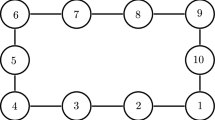Abstract
In this paper, the consensus problem of hierarchical multi-agent systems has been addressed. A novel approach is employed to divide the agents into different groups with different number of agents. In each group, agents communicate with each other under a constant delay. However, the groups in the upper layer interact with each other with a time-varying delay. The topologies of the groups are also considered to be different. In order to prove the stability of the system, a Lyapunov–Krasovskii functional is employed, and proper conditions for the consensus of this hierarchical system are provided via LMIs. Finally, the results of this research are validated through simulations.





Similar content being viewed by others
References
Duan Z, Zhai G, Xiang Z (2015) State consensus for hierarchical multi-agent dynamical systems with inter-layer communication time delay. J Frankl Inst 352(3):1235–1249
Duan Z, Zhai G, Xiang Z (2016) Exponential consensus for hierarchical multi-agent systems with switching topology and inter-layer communication delay. IET Control Theory & Applications. https://doi.org/10.1049/iet-cta.2015.0548
Godsil C, Royle GF (2013) Algebraic graph theory, vol 207. Springer, Berlin
Haghighi R, Cheah CC (2012) Multi-group coordination control for robot swarms. Automatica 48(10):2526–2534
Hara S, Shimizu H, Kim TH (2009) Consensus in hierarchical multi-agent dynamical systems with low-rank interconnections: analysis of stability and convergence rates. In: American control conference, 2009. ACC’09., IEEE, pp 5192–5197
He DX, Xu GH, Guan ZH, Chi M, Zheng DF (2015) Hybrid coordination of multi-agent networks with hierarchical leaders. Commun Nonlinear Sci Numer Simul 27(1):110–119
Jadbabaie A, Lin J, Morse AS (2003) Coordination of groups of mobile autonomous agents using nearest neighbor rules. IEEE Trans Autom Control 48:988–1001. https://doi.org/10.1109/TAC.2003.812781
Jin XZ, Wang SF, Yang GH, Ye D (2017) Robust adaptive hierarchical insensitive tracking control of a class of leader–follower agents. Inf Sci 406:234–247
Jin XZ, Zhao Z, He YG (2018) Insensitive leader-following consensus for a class of uncertain multi-agent systems against actuator faults. Neurocomputing 272:189–196
Li X, Su H, Chen MZ (2015) Consensus networks with time-delays over finite fields. Int J Control. https://doi.org/10.1080/00207179.2015.1110755
Liu CL, Liu F (2011) Stationary consensus of heterogeneous multi-agent systems with bounded communication delays. Automatica 47(9):2130–2133
Mesbahi M, Egerstedt M (2010) Graph theoretic methods in multiagent networks. Princeton University Press, Princeton
Olfati-Saber R, Murray RM (2004) Consensus problems in networks of agents with switching topology and time-delays. IEEE Trans Autom Control 49(9):1520–1533. https://doi.org/10.1109/TAC.2004.834113
Roy S (2015) Scaled consensus. Automatica 51:259–262. https://doi.org/10.1016/j.automatica.2014.10.073
Smith SL, Broucke ME, Francis BA (2005) A hierarchical cyclic pursuit scheme for vehicle networks. Automatica 41(6):1045–1053
Tsubakino D, Hara S (2010) Eigenvector-based characterization for hierarchical multi-agent dynamical systems with low rank interconnection. In: 2010 IEEE international conference on control applications (CCA), IEEE, pp 2023–2028
Tsubakino D, Hara S (2012) Eigenvector-based intergroup connection of low rank for hierarchical multi-agent dynamical systems. Syst Control Lett 61(2):354–361
Wenwu Y, Chen G, Cao M (2010) Some necessary and sufficient conditions for second-order consensus in multi-agent dynamical systems. Automatica 46(16):1089–1095. https://doi.org/10.1016/j.automatica.2010.03.006
Williams A, Glavaški S, Samad T (2004) Formations of formations: hierarchy and stability. In: Proceedings of the 2004 American control conference, vol 4. IEEE, pp 2992–2997
Wu M, He Y, She JH, Liu GP (2004) Delay-dependent criteria for robust stability of time-varying delay systems. Automatica 40(8):1435–1439
Yu J, Wang L (2010) Group consensus in multi-agent systems with switching topologies and communication delays. Syst Control Lett 59(6):340–348
Zheng Y, Wang L (2012) Consensus of heterogeneous multi-agent systems without velocity measurements. Int J Control 85(7):906–914
Author information
Authors and Affiliations
Corresponding author
Rights and permissions
About this article
Cite this article
Rikhtegar Ghiasi, A., Dehghani Aghbolagh, H., Hashemzadeh, F. et al. Consensus Control of Hierarchical Multi-agent Systems with Constant and Time-Varying Delays. Iran J Sci Technol Trans Electr Eng 42, 479–484 (2018). https://doi.org/10.1007/s40998-018-0089-x
Received:
Accepted:
Published:
Issue Date:
DOI: https://doi.org/10.1007/s40998-018-0089-x




